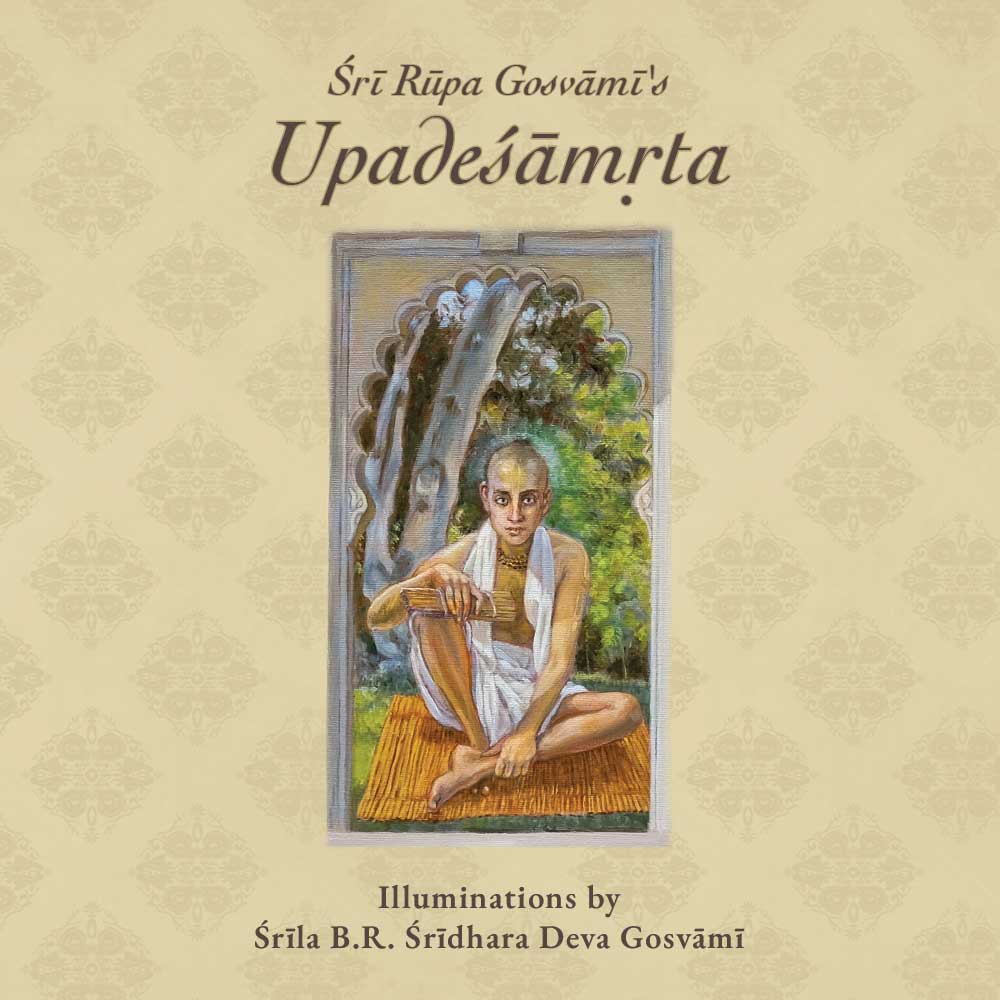Upadeśāmṛta Chapter Overview
Śrī Rūpa Gosvāmī’s Upadeśāmṛta (The Nectar of Instruction) is presented along with the illuminations (commentary) of Śrīla B.R. Śrīdhara Mahārāja. This book includes the original Devanāgarī and word for word translation of each verse, illuminations by Śrīla B.R. Śrīdhara Deva Gosvāmī Mahārāja, an extensive introduction delineating the history of the Upadeśāmṛta, 6 colour plates and brief biographies of Śrī Rūpa Gosvāmī and Śrīla Śridhara Mahārāja.
Let me offer my respectful obeisances unto my initiating spiritual master, Śrīla A.C. Bhaktivedānta Svāmī Prabhupāda, who rescued me from the ocean of repeated birth and death, and who established within me the understanding of what is what in relation to my ultimate prospect – love of God. It was he who guided us to the lotus feet of Śrīla Bhakti Rakṣaka Śrīdhara Deva Gosvāmī Mahārāja, who out of his causeless mercy, gave us shelter and protected us after the calamitous reactions that took place after the departure of Śrīla Prabhupāda. It was Śrīla Śrīdhara Mahārāja who refined and enhanced our conception of divinity. What Śrīla Prabhupāda gave us in his books, Śrīla Śrīdhara Mahārāja drew out the essence of those instructions and imparted them to the Vaiṣṇava world, both by practical and personal directives to all that came to hear from him.
Śrīla Rūpa Gosvāmī penned this great and formidable treatise, Upadeśāmṛta, a practical guide on how to proceed in bhakti step by step, beginning with sense, mind and emotional control, enabling one to move towards the highest level of devotional sentiments in line with the maidservants of Gāndharvā Śrī Rādhā, the topmost servant of Śrī Govindadeva.
Inspired from deep within, Śrīla Śrīdhara Mahārāja gives his clear and spontaneous, inspirational śikṣā on each and every verse penned by Śrīla Rūpa Gosvāmī, who is none other than Śrī Rūpa Mañjarī. These clear and illuminating revelations prove that Sarasvatī Ṭhākura saw in Śrīla Śrīdhara Mahārāja a person qualified to carry on the proper conception of divinity, just as Mahāprabhu Himself considered Rūpa Gosvāmī to be the most qualified person to receive and elucidate His directives. The explanations spoken by Śrīla Śrīdhara Mahārāja to these eleven verses are taken from a compilation of various discussions with disciples of His Divine Grace Śrīla A.C. Bhaktivedanta Svāmī Prabhupāda over a period of seven years.
It was the arduous sevā of our dear friend and godbrother, Śrīpāda Bhakti Gaurava Narasiṅgha Mahārāja (Jagat-Guru Svāmī) along with his dear disciples who extracted the relevant śikṣā and correlated it to the appropriate verses of Śrīla Rūpa Gosvāmī that makes this exceptional treatise of devotion an absolutely necessary addition to one’s progressive march towards the ultimate goal of life – service in the line of Śrī Śrī Gāndharvikā-Govindasundara as propounded by Śrīla Rūpa Gosvāmī.
May the readers of this work be blessed by the compassionate hand of our Guardians in order that that they may give proper and clear directives to all that they meet, so that they may become family members of Govinda. As a result, the Vaiṣṇava community will prosper in a happy, harmonious and progressive way.
Svāmī Bhakti Kiśora Āraṇya


